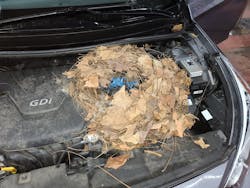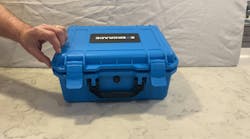Analyzing the cause of a no-start vehicle can be complicated, as there are many variables to consider. Vehicle no-start situations often fall into two categories: cranking no-start or no-crank when the ignition key is turned, or when the start button is pushed.
We are going to examine the no-crank, no-start scenario, and look at some of the more common issues that can cause this situation. In this scenario the starter motor does not crank the engine over when the operator asks it to.
Typically, the no-start/no-crank diagnostics will follow one of three paths: a dead or weak battery, the starter motor solenoid clicks but the starter motor doesn’t function, or the starter solenoid doesn’t receive a “crank the engine” command voltage signal.
Even before we attach a scan tool to the vehicle to start our diagnostics, we need to perform a good visual inspection and pay attention to the most obvious areas first. Is the battery fully charged and able to supply the needed voltage to the starter motor through clean and tight battery connections? Is there a rodent’s nest under the hood that has damaged wiring? Have there been earlier repairs on the starting system? Are there aftermarket accessories installed? The power of a thorough visual inspection cannot be underestimated.
When starting any diagnostics, always be sure to check for TSBs first. Certain 2018-2023 Honda SUV models have an issue with water intrusion into the starter motor that can freeze in the winter and prevent the starter motor from functioning. This issue could be overlooked or hidden if the vehicle is in the shop and thaws before the diagnostics are performed. The fix is to replace the starter motor with a modified design.
Start with the battery. The proper testing of the battery should be the first step in our diagnostics. Without an adequate supply of energy from the battery the engine will not start. Clean and tight battery connections are often overlooked when diagnosing, but this inspection is crucial, especially with so many batteries being remotely located in various parts of today’s vehicles. Evaluating the battery with the proper battery tester is important, and the use of a digital tester that will compensate for battery temperature and the specific battery design is now the preferred method. The best place to accurately evaluate a battery when dealing with a no-start, is directly on the battery’s negative and positive terminals. Often getting to the battery connections can reveal the issue (think of the Dodge Journey battery in the left front fender location). If we have ruled out the battery as the cause of our no-crank situation, we will move on to the next step.
What if the starter motor is not receiving the command to crank over the engine? When the vehicle operator wants the engine to start, a low-current control signal will be sent to activate the starter solenoid. But if that activation signal isn’t sent, the engine won’t crank.
The PCM will typically be the module that will supply power to the starter activation control circuit (often via a relay), but it will be based on decisions and data from other modules on the vehicle. The security system is heavily involved. It will confirm that the correct key, key fob, key card or cell phone device (digital key) is valid and confirm that the operator is allowed to request an engine start. Other components involved in the starting system are simpler, and the brake and clutch pedal inputs are important for safety. These inputs can be verified using a scan tool and looking at the proper data PIDs.
The starting system diagram for a 2018 F150 V6-3.5L highlights the interconnection of several modules to enable the cranking of the engine. The Body Control Module (BCM), Powertrain Control Module (PCM), Passive Anti-Theft System (PATS), Gateway Module, Integrated Keyhead Transmitter (IKT), Ignition Switch/Push Button Start, Radio Transceiver Module (RTM), Audio Front Control Module (ACM) and inputs from the automatic transmission must all share and agree on various pieces of information, before the starter motor will crank the engine.
Example: Once the PCM on a Ford F-150 receives all the correct inputs (park or neutral inputs from the automatic transmission) and data from other modules, the PCM will supply voltage to the starter relay and the ACM will supply the ground to the starter relay coil. This will activate the relay and supply voltage to the starter solenoid to crank the engine. Note that the F-150 is controlling both sides of the starter relay via two separate modules.
Some 2012-2017 VW Beetles and Jetta models have an issue with the push-button start button itself, creating a no-crank, no-start condition. These VWs typically will crank fine with the switch electrically connected and removed from the dash and held in your hand when activated.
There are many things that can cause the crank activation signal not to be sent to the starter motor. Blown fuses, pitted and defective relays, corrosion, chewed wires, melted terminals in fuse/relay boxes can often be found. The addition of aftermarket security systems, remote start units, tracking and disabling devices can be harder to find, but are often spliced into the starter control signal system. If these units fail, they can easily cause a no-crank situation with no codes or wiring diagrams to aid in the diagnostics. A non-OEM key fob is often a good sign of aftermarket security and remote start systems, which are known to cause no-crank issues.
If we have verified that the starter solenoid is receiving the correct signal at the starter motor, we can move on to the last step in the no-crank, no-start diagnostic.
What if the starter motor is unable to crank the engine, but the starter solenoid clicks? Ensuring that the crankshaft will turn may sound simple, but a seized engine, a seized A/C compressor or other seized rotating part, linked to the engine, can easily stop a starter motor from cranking an engine.
After verifying the crankshaft will turn, we need to confirm that the starter motor has a good positive battery feed and a good ground circuit. Voltage Drop (VD) testing is the best method to verify any issues in the voltage supply and ground circuits. The VD testing exposes corrosion or excessive resistance that may not be visible. The battery feed cable to the starter motor should have less than a 0.5-volt VD when tested. The negative side should have the same reading: 0.5-volt VD.
If the VD is above 0.5V on either side during testing, either the cable is bad or there is a corrosion issue that will need to be addressed. If the readings are good and less than 0.5-volt VD on both sides, the starter motor is the likely culprit and needs to be changed (after double checking the starter control signal).
Positive and negative starter cables and connections aren’t the only area that corrosion can cause a no-crank, no-start. The use of environmentally friendlier road clearing and de-icing agents such as magnesium chloride and calcium chloride-based products has led to the accelerated corrosion of metals on vehicles, especially copper. The often-unprotected braided copper cable that supplies battery voltage from the starter solenoid to the starter motor field windings can be subjected to this accelerated corrosion. The corrosion of this braided copper cable can eventually lead to a total starter motor failure. Finding the failure of this part isn’t always straight forward, as many starter motors are not easily visible.
If you can visibly see the starter motor, when the start command is sent, you may see sparks during the first solenoid connection. Or you may be able to see the melted, broken or separated braided copper cable (carefully wiggling the cable may expose the corrosion failure if you are able to access the starter visually to confirm your diagnostic). Repairing this cable is typically addressed by replacing the entire starter motor.
But these aren’t the only braided copper cables on the vehicle that can cause the starter motor not to function due to corrosion. Braided copper chassis ground straps that are used in various areas of the vehicle are also subject to corrosion. Many GM trucks and vans, various BMWs, and Mini Coopers fall victim to the corrosion of their braided copper ground straps. The results of this ground side corrosion can cause no-start, no-crank failures or voltage drops that cause slow cranking, stalling, multiple DTCs, warning lights, drivability issues and other concerns.
Certain 2014-2018 GM Sierra pickup trucks have an issue caused by the air conditioner drain dripping on the chassis ground connection on the vehicle’s frame, which causes cable and connection corrosion. These GM truck ground cables can also corrode inside the protective plastic shield and often look swollen at the point of corrosion. The fix is to clean the connection to the frame or replace the main chassis battery ground cable/battery sensor module assembly.
Certain BMW models used a braided copper cable between the engine/transmission assembly and the chassis. Often this ground cable, on the right side of the chassis, behind the right front wheel, can’t be seen easily until the large under-engine shield is removed. Once the shield is removed, these BMW cables often corrode to dust when touched. This corrosion may result in a no-crank situation, or it could cause module communications issues, warning lights and electronic transmission range issues, often leading to misdiagnosis.
Performing a voltage drop across these connections is the best way to verify the issue, especially if the cable looks OK visually, as these vehicles all have remotely mounted batteries.
Diagnosing a no-crank situation today is going to require a scan tool, and an up-to-date information system that will supply the needed starting system wiring diagrams, relay and fuse locations. When tackling a no-crank diagnostic, don’t forget to look closely for non-factory installed security systems, DLC-attached tracking devices, and other aftermarket installed components that could be interfering or inhibiting the crank signal command.
Performing a full system scan of all the vehicles modules is crucial, due to their heavy interdependence. A DTC in a seemingly unrelated module could be involved in the cranking of the engine, and that module may have set a DTC that could help diagnose the no-crank issue. Understanding how the system is intended to function is important, and a look at the wiring diagrams often shows the functionality. The F-150 is a good example of this with the PCM supplying the power and the ACM applying the ground for enabling the starter relay operation. It’s not something even the most seasoned tech may have looked at.


